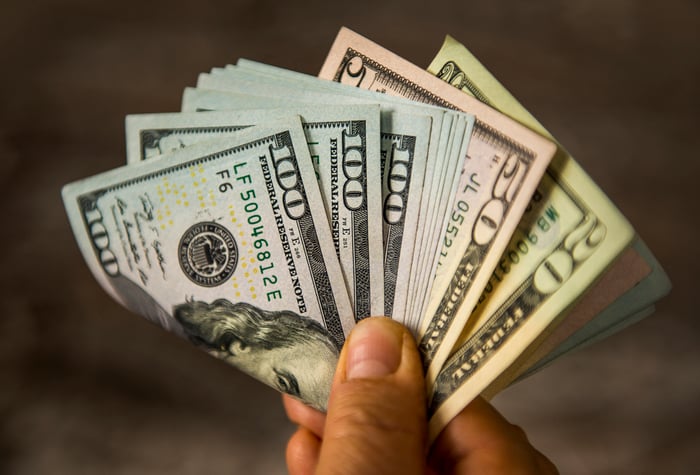Although it's not something investors enjoy hearing, the truth is that stock market crashes and corrections happen often.
Since the beginning of 1950, the benchmark S&P 500 has undergone 38 separate declines of at least 10%. This works out to a double-digit percentage drop, on average, every 1.87 years. Even though the stock market doesn't adhere to averages, it does plainly show how commonplace crashes and corrections are.

Image source: Getty Images.
But the thing to understand about crashes and corrections is that they're nothing to fear. In fact, seeing as how every move lower throughout history has eventually been erased by a bull-market rally, a crash or steep correction can always be viewed as a buying opportunity for patient investors. The big question is simply what to buy.
The answer may well be dividend stocks. Since companies that pay a dividend are almost always profitable and time-tested, they're the perfect place to put your money to work during periods of heightened volatility.
The problem income investors face is wanting to maximize their yield while minimizing their risk. Generally, once a stock hits high-yield status (4%, or higher), risk and yield tend to be correlated. This is to say that as a stock's yield climbs, so does the likelihood that income investors won't net the yield they're counting on. Since yield is a function of payout relative to share price, a failing or struggling business with a plunging share price can look like an income bargain but be a bona fide trap.
Thankfully, this isn't the case with all high-yield dividend stocks. If a stock market crash or steep correction were to occur, the following trio of high-yield stocks can be confidently bought by investors.

Image source: Getty Images.
Annaly Capital Management: 10.3% yield
The biggest no-brainer buy during a crash among ultra-high-yield stocks just might be mortgage real estate investment trust (REIT) Annaly Capital Management (NLY -0.32%). Annaly is yielding north of 10%, has averaged about a 10% yield for the past two decades, and has cumulatively paid out more than $20 billion in dividends since its inception in 1997.
Mortgage REITs like Annaly are highly interest-sensitive, but perfectly positioned to benefit from the current rate environment. Mortgage REITs borrow money at low short-term lending rates and use that capital to purchase assets (mortgage-backed securities) with higher long-term yields. The wider the gap between the average yield a mortgage REIT receives from its assets and its average borrowing rate (this gap is known as net interest margin), the more profitable it can be.
During the early stages of an economic recovery, it's quite common for the interest rate yield curve to steepen. This provides a lift to longer-term asset yields while weighing on short-term yields. In other words, it's the perfect scenario for Annaly to see its net interest margin expand.
What's more, the company almost exclusively purchases agency-backed securities. An agency asset is backed by the federal government in the event of default. While this added protection does lower the yield Annaly can expect to receive on the mortgage-backed securities it purchases, it also allows the company to use leverage to its advantage.

Image source: Getty Images.
Philip Morris International: 5.1% yield
I'll freely admit that tobacco stocks aren't anywhere close to the growth story they once were. Stringent regulations, coupled with a better understanding of the negative consequences of smoking tobacco products, have weighed on cigarette manufacturers. But in spite of these concerns, Philip Morris International (PM 1.39%) and its rock-solid 5.1% yield continue to deliver for patient investors.
To begin with the basics, tobacco products contain nicotine, which is an addictive chemical. This addictive nature of tobacco products is what affords Philip Morris, the company behind the premium Marlboro brand in markets outside the U.S., exceptional pricing power. Even as cigarette shipments fall, revenue is ticking higher because consumers are willing to pay more for tobacco products.
More specific to Philip Morris, it benefits from geographic diversity. The company operates in more than 180 countries worldwide. The advantage of being geographically diverse is that it allows Philip Morris to take advantage of stronger growth prospects for tobacco products in emerging markets. Even with tighter regulations on the tobacco industry in a number of developed markets, Philip Morris is able to lean on emerging markets to balance things out.
But don't think for a moment that management isn't looking to the future. Philip Morris has invested heavily into its IQOS heated tobacco system as an alternative to traditional cigarettes. Through the first half of 2021, shipment volume for heated tobacco units was up 30.1% to 46.1 billion units.
The high-growth days for tobacco stocks are long gone, but giants like Philip Morris can still deliver, regardless of how well or poorly the stock market is performing.

Image source: Getty Images.
Walgreens Boots Alliance: 4% yield
A third high-yield dividend stock investors can buy with confidence if there's a stock market crash is pharmacy chain Walgreens Boots Alliance (WBA -1.33%). Though healthcare stocks aren't known for robust payouts, Walgreens is parsing out about three times the annual yield of the S&P 500.
What makes Walgreens such an intriguing investment is its potential following the coronavirus pandemic. Foot traffic into its stores and clinics slowed significantly in 2020, hurting the company's operating results and driving down its share price. This short-term pain should lead to long-term gains for investors focused on the company's multipoint turnaround plan.
As is common with turnaround plans, management has identified numerous areas where costs can be reduced and operating efficiencies improved. According to the company, it recognized over $2 billion in annual cost savings in fiscal 2021. The previous goal had simply been to recognize $2 billion in annual cost savings by the end of fiscal 2022.
At the same time it's slashing costs, Walgreens is also investing heavily in digitization. While there's no question brick-and-mortar stores are the company's bread-and-butter revenue source, the pandemic has taught retailers of all sizes how important it is to promote direct-to-consumer sales. Walgreens is bolstering its omnichannel presence and should see steady organic growth from its efforts.
Perhaps most important, Walgreens Boots Alliance has partnered up with VillageMD to open over 600 value-based clinics in Walgreens' stores by 2025 in more than 30 U.S. markets. Walgreens recently upped its commitment to this partnership by investing $5.2 billion into VillageMD, increasing its stake in the company to 63%. Whereas most in-store clinics can't handle more than vaccines or a sniffle, these co-located clinics will be physician-staffed and the perfect funnel to Walgreens' higher-margin pharmacy.





